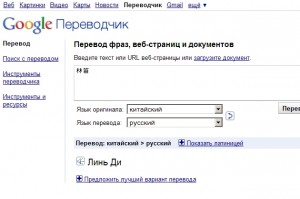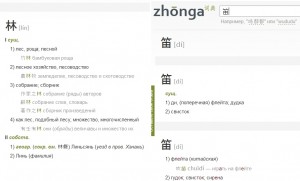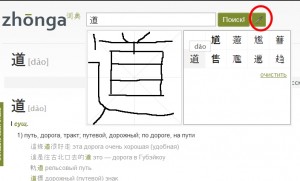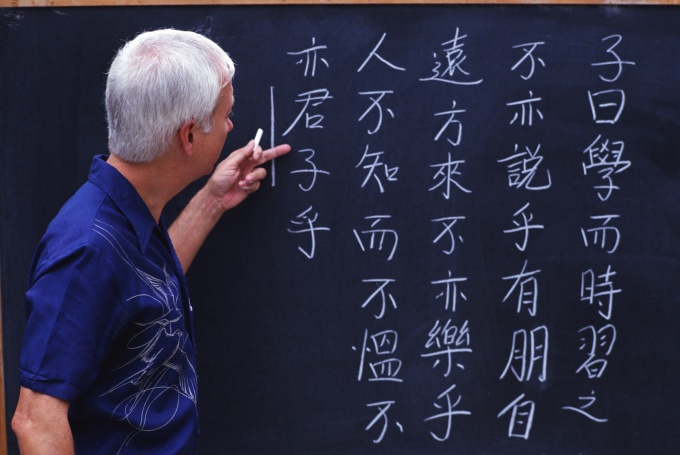Translation of Russian words into Chinese characters
This problem is faced by almost anyone whose interests in China and Chinese culture slightly different from zero. I needed to translate a set of hieroglyphs for the first time when I wanted to put a Chinese-style theme on my first blog - I didn’t find a suitable one in RuNet, but I found it on a Chinese blog. I don't remember exactly what problems during the installation (in my opinion, a plugin conflict) pushed me to this feat, but I had to work hard. Today I will talk about how easy it is to translate Chinese characters into a language we understand.
1. Most effective method– find a professional Sinologist and persuade him for free (or, if it doesn’t work out, persuade him for a fee) to translate the n-th number of these obscure icons. I doubt that the search for a person who will translate for you for free will be crowned with success. Thus, this method is worth using when you have free finances.
2. Take advantage. Free, fast, and… quite often with a few bugs. However, the general meaning can be caught. This way I read Chinese blogs.
3. In Lately I use a completely different resource - . Let's take a closer look at it here. In addition to the translation of single hieroglyphs, which is carried out according to several big dictionaries, Dzhunga can also translate combinations of several hieroglyphs. , I took the liberty of translating not only the name of the group, but the name of its leader. I will demonstrate the difference in their use using the example of Google and Jungi.
林笛
– Lin Di (so these hieroglyphs are pronounced). Google came up with this result: 
Dzhunga gave out two hieroglyphs in the form of hyperlinks. In the combined screenshot I give the values of each: 
In my opinion, it would be quite correct to translate as "Forest Flute". I suspect that in translation from Russian into Chinese, Dzhunga will be better than Google.
There is another great opportunity. There are situations when we know how a character is written, but we do not have it in the computer. For example, you, (Igor is just now publishing a series of articles with tips on how to do it right), and you have instructions in Chinese. In this case, we can draw a hieroglyph and Dzhunga will recognize it and translate it for us. Click on the picture and enjoy my "mouse calligraphy". 
Well, now, if you come across these terrible hieroglyphs, you know how to deal with them.
By the way, who can determine what the hieroglyphs mean in the very first, header picture of this post?
ical writing, among them Chinese, Japanese and Tangut. IN Korean for a long time used Chinese characters (hanchcha), but today they are practically out of use. Tangut is little known, and the first two are quite popular all over the world. But their writing system is so different from the usual alphabetic European languages that it is difficult to translate unfamiliar hieroglyphs.
Instruction
If you do not take into account the Tangut script, hanchcha and ancient languages, the character may be Japanese or Chinese. And since the Japanese borrowed the letter from the Chinese several centuries ago, hieroglyphs are the same in both languages. Therefore, the meaning of the character from the Chinese text can be found in Japanese dictionaries or vice versa. The only thing to know: in the country rising sun still use the ancient, traditional spelling, while in China some hieroglyphs have been simplified. However, dictionaries still indicate both options.
If you found a character on a Japanese or Chinese site, then the easiest way to translate it is using online dictionaries or chiki by copying the character and pasting it into the search bar. For example, use Google translator or any dictionary, a large database of hieroglyphs is in the Big Chinese-Russian Dictionary at http://bkrs.info/. You can also download and install dictionary programs to always be able to translate hieroglyphs.
If you need to find a character that exists only as an image, you will have to spend more time translating. There are several options. Find on the Internet a list of common characters for the language you need. For example, in Japanese, the alphabet is more often used, and there are much fewer hieroglyphs than in Chinese - no more than two thousand are common. You can find a list of required to study Japanese characters and look for your sign in them. Or you can find sites with lists of popular Chinese characters: wishes for happiness, health, money, prosperity. If your sign is printed on a T-shirt, souvenir, postcard, this method will help you.
Find a dictionary that supports "manual search", where you can redraw the character in a special field. The program will compare with the characters available in the database and offer suitable options with translation. Try to reproduce all the features as accurately and clearly as possible.
And finally, you can find the translation of the hieroglyph in ordinary dictionaries. Exist different types search: by the number of features, by "keys" ( constituent parts), by the first or last features. For example, in the Kotov dictionary, the search is organized by the first two lines in the hieroglyph, in the large Mudrov dictionary, by the last. Finding desired sign according to these characteristics in the list (which is usually located at the end of the dictionary), open the page whose number is indicated next to the hieroglyph.
Instruction
The most effective way is to know that you have a friend who speaks Chinese well. The probability of such a case is negligible. But you can take advantage paid services such people. In your city, for sure, there are such people. No one will do it for free, so this option is suitable if you have free money.
If you don’t have free money, then you should turn to the Internet. There are now several translation services on the territory of the Russian Internet. Each such service differs only in approximate translation. The most common, in every sense of the word, translator from Google. This service produces very quickly, one might say "on the fly", but there are errors in its work. If you need to capture only the general meaning, then this service will suit you.
Using the Zhonga online translator, you will notice a noticeable difference in translations. The same words in Google and Zhonga have different meaning. According to users of this service, Zhonga translates much better than Google, but is not ideal in terms of translation. This service can be used as an alternative. After all, on bezrybe and cancer pike. If you need an accurate translation, then only a living person who speaks this language is ideal.
The art of inscription hieroglyphs there are centuries. To truly learn how to draw, you need to comprehend not only the rules for the direction of the brush, but also the laws of the movement of thoughts, because this is a whole philosophy. To take the first tentative step, try writing the character for "bamboo", which symbolizes health and resilience.
You will need
- Ink, brush, paper
Instruction
In writing various elements of the hieroglyph, certain priorities are observed: first, the upper lines are written, and then the lower ones; elements on the left are written before dashes on the right. When crossing lines, the horizontal is written first, and then the vertical.
Our hieroglyph contains two horizontal lines. Let's write the left one first. Divide the square horizontally into 4 equal parts. The horizontal line will be located on the border between the first and second upper parts of the square. Draw a line horizontally from left to right, at the end increase the pressure and point the brush tip up to the left.
Draw the top vertical line by analogy with the first.
Draw the last vertical line from top to bottom, towards the end, loosen the pressure on the brush and swipe it up to the left.
Related videos
Interest in our great eastern neighbor - China - is constantly growing. Business, culture, tourism, humanitarian sphere - these are just a few areas of cooperation between our states. One of the most serious problems, inhibiting these processes - language. Chinese and Russian are considered very difficult languages to learn, so getting a qualified translator is not easy.

Instruction
It is worth mentioning right away that there are very few connoisseurs of the Chinese language in Russia and their services are far from free. Many seek help where there is more than enough of this goodness - on the Internet.
The well-known Google translator is in great demand. A well-established, run-in program will translate the text with small errors, which is quite natural. However, if one strains properly, the general meaning of the text can be caught. This is enough, for example, to read Chinese blogs.
In addition, there are many other online translators on the Internet. Among them you can find those that translate not only individual hieroglyphs, but also their combinations. To make the translation better, you should start with the administrative part. This will help to understand the specifics of the chosen program and its scheme.
When working with online translators, it is desirable to have at least general ideas by html, which is very important when fitting style files. The sizes of Chinese characters are much smaller than their Russian translation, which makes it necessary to harmonize styles or reduce the length of Russian words. As a result, there may be problems with common sense text and readability.
You should translate slowly, delving into the meaning of each translated phrase. You should insert no more than 10-15 phrases into the translation window so as not to lose the meaning.
It is very convenient to work with programs where there are two windows. In this case, 10-15 phrases of hieroglyphs can be placed in one window, and each hieroglyph can be translated in the second.
By the way, the activities of some translation agencies are structured in such a way that operations that do not require a creative approach are performed by a computer, while editing and proofreading of the text is carried out by employees of the agency.
Japanese culture is gaining more and more popularity in the world. And in order to speed up the process of spreading culture and progress, you need to understand at least a little the language of the Land of the Rising Sun. First of all, you need to be able to translate texts from Japanese. However, this is not easy to learn.

Instruction
When translating from Japanese, remember that such a translation is one of the most difficult. After all, Japanese writing is not just letters on paper, but a whole art. First, get familiar with the spelling of symbols. Japanese writing can perfectly combine hieroglyphs, national characters "kanna", Latin alphabet and Arabic numerals.
In addition, when translating a text from Japanese, it is imperative to include both figurative thinking and knowledge of the exact sciences. Creative thinking necessary in order to understand fiction. After all, many hieroglyphs carry the load of a whole word. Knowledge of sciences will be useful in case of translation of specialized technical literature. That is, where there is no room for speculation.
When starting to translate, do not forget to first read the text completely, understand the main idea, and determine in what ways the author conveys the idea to the reader. After that, look for those combinations of signs or hieroglyphs that are stable and fixed. Then proceed to the analysis of each individual hieroglyph. Check their spelling with a dictionary. After all, if you mix up at least one of the slopes of the letter, you can change the meaning of the whole sentence.
Also, do not forget to ask about the era in which the author lived (if we are talking about translation literary texts), because it is the events taking place at that time that often reflect the character of the whole work as a whole. Of no small importance is the fact from which environment the author comes from or about which he writes.
If the science of translation from Japanese does not lend itself to you, then you can turn to professionals. They will issue the necessary text for you for a certain amount. But before entrusting this matter to strangers, try to translate the source material yourself. After all, the Japanese language is one of the most ancient and interesting languages. Therefore, you will have only the most positive impressions from communicating with such a culture.
Related videos
Taobao.com is China's largest online marketplace.
You can find almost everything there. The only drawback of Taobao is its language inaccessibility for residents of other countries.




